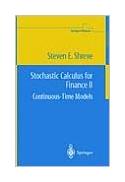|
||
podział tematyczny • wydawnictwa anglojęzyczne podział tematyczny Newsletter: • Zamów informacje o nowościach z wybranego tematu Informacje: • sposoby płatności i dostawy • kontakt • Cookies na stronie • Regulamin zakupów Napisz propresssp@gmail.com |
STOCHASTIC CALCULUS FOR FINNCE II CONTINUOUS - TIME MODELSSHREVE S.wydawnictwo: SPRINGER , rok wydania 2004, wydanie Icena netto: This book evolved from the
first ten years of the Carnegie Mellon professional Master's program in Computational
Finance. The contents of the book have been used successfully with students whose
mathematics background consists of calculus and calculus-based probability. The text gives
both precise statements of results, plausibility arguments, and even some proofs. But more
importantly, intuitive explanations, developed and refine through classroom experience
with this material are provided throughout the book. Volume I introduces the fundamental
concepts in a discrete-time setting and Volume II builds on this foundation to develop
stochastic calculus, martingales, risk-neutral pricing, exotic options, and term structure
models, all in continuous time. This second volume develops stochastic calculus, martingales, risk-neutral pricing, exotic options, and term structure models, all in continuous time. Chapter summaries and detailed illustrations are included. Classroom-tested exercises conclude every chapter. Some of these extend the theory, and others are drawn from practical problems in quantitative finance. Master's-level students and researchers in mathematical finance and financial engineering will find this book useful. Steven E. Shreve is Co-Founder of the Carnegie Mellon MS Program in Computational Finance and winner of the Carnegie Mellon Doherty Prize for sustained contributions to education. "Steve Shreve is well known in the quant community as an extraordinary researcher and a brilliant communicator. I have often referred to his infamous lecture notes as the definitive treatment on derivative security pricing and hedging. I am delighted that these notes have now graduated like so many of his students. Providing a review on the resulting book is a little like being asked to critique the Bible. It suffices to say that I think this is the first book that anyone should read as an entree into this fascinating field." Peter Carr Head of Quantitative Research, Bloomberg LP and Director of the NYU Master's Program in Mathematical Finance 546 pages Księgarnia nie działa. Nie odpowiadamy na pytania i nie realizujemy zamówien. Do odwolania !. |


